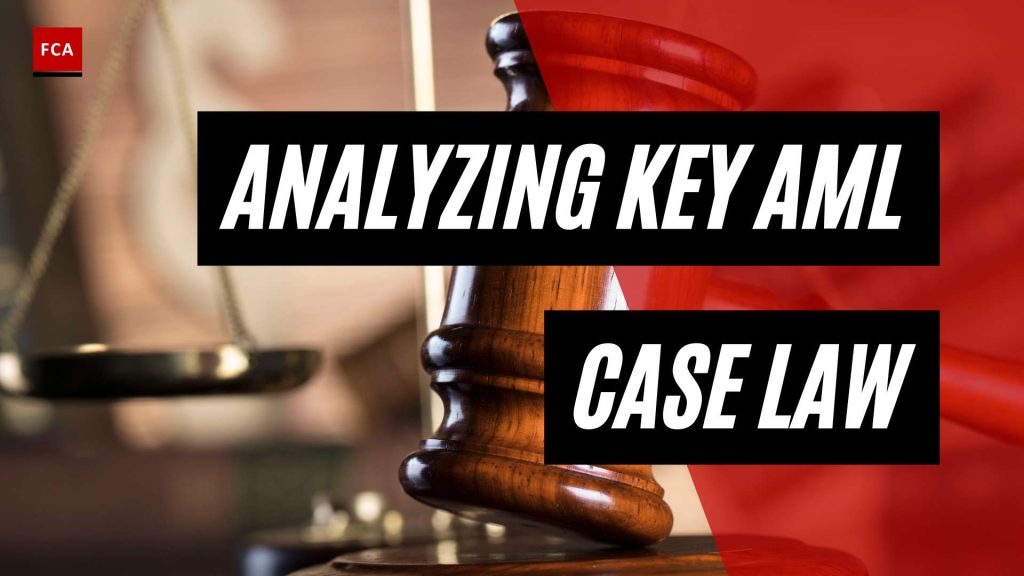Understanding AML Compliance Framework
To combat financial crimes such as money laundering, financial institutions worldwide are required to develop and implement Anti-Money Laundering (AML) compliance programs. These programs are essential for detecting and reporting suspicious activities like tax evasion, fraud, and terrorist financing. They play a crucial role in ensuring that financial institutions adhere to AML legal requirements and regulatory guidelines.
Importance of AML Compliance Programs
AML compliance programs are necessary to protect the integrity of the financial system and maintain public trust. By establishing robust AML processes, financial institutions can mitigate risks associated with money laundering and protect themselves from legal and reputational harm.
Implementing an effective AML compliance program allows financial institutions to:
-
Detect and report suspicious activities: AML compliance programs focus on detecting unusual or suspicious transactions that may indicate money laundering. By monitoring and analyzing customer transactions and behaviors, financial institutions can identify and report potentially illicit activities to the appropriate authorities.
-
Establish comprehensive policies and procedures: AML compliance programs include the development and implementation of comprehensive policies and procedures. These guidelines outline the steps to be followed when identifying and reporting suspicious activities, conducting due diligence on customers, and implementing internal controls.
-
Conduct risk assessments: Financial institutions need to assess the risks associated with their operations and customer base. AML compliance programs should include periodic risk assessments to identify areas of vulnerability and implement appropriate risk mitigation measures.
-
Implement Know Your Customer (KYC) programs: KYC programs are an integral part of AML compliance. They involve verifying the identity of customers, understanding their financial activities, and assessing the level of risk they pose. KYC procedures ensure that financial institutions have a clear understanding of their customers and can monitor their transactions effectively.
-
Carry out independent audits: AML compliance programs should undergo independent testing and auditing by qualified third-party organizations. Regular audits help identify any weaknesses or gaps in the program and ensure compliance with regulatory requirements. Audit reports should be delivered to senior management and the Audit Committee to maintain transparency and accountability.
-
Continuous monitoring and testing: AML compliance programs require ongoing monitoring and testing of internal controls, policies, and procedures. Financial institutions should establish mechanisms to track and analyze customer transactions, identify patterns of suspicious activities, and promptly report any concerns.
-
Provide AML training: Training is crucial for ensuring that employees understand their roles and responsibilities in preventing money laundering. AML compliance programs should include comprehensive training programs to educate employees on AML regulations, detection techniques, and reporting obligations.
Key Components of AML Compliance Programs
An effective AML compliance program comprises several key components. These include:
-
Policies and procedures: Financial institutions should establish clear and comprehensive policies and procedures that outline the steps to be followed when identifying and reporting suspicious activities, conducting due diligence on customers, and implementing internal controls.
-
Risk assessments: Regular risk assessments help identify areas of vulnerability and ensure that appropriate risk mitigation measures are in place. These assessments consider factors such as customer profiles, transaction volumes, and the geographical regions in which the institution operates.
-
Know Your Customer (KYC) programs: KYC procedures involve verifying the identity of customers, understanding their financial activities, and assessing the level of risk they pose. KYC programs ensure that financial institutions have a clear understanding of their customers and can monitor their transactions effectively.
-
Independent audits: AML compliance programs should undergo independent testing and auditing by qualified third-party organizations. These audits help identify weaknesses or gaps in the program and ensure compliance with regulatory requirements.
-
Continuous monitoring and reporting: Financial institutions should establish mechanisms to track and analyze customer transactions, identify patterns of suspicious activities, and promptly report any concerns. Continuous monitoring and reporting enable institutions to detect and address potential money laundering risks.
By implementing these key components, financial institutions can establish robust AML compliance programs that effectively detect and deter money laundering activities. These programs help safeguard the financial system and maintain compliance with AML regulations and guidelines.
AML Legal Challenges and Case Law
When examining the landscape of anti-money laundering (AML) compliance, it is crucial to consider the legal challenges and case law that have shaped the industry. This section focuses on three key aspects: the personal liability of bank officials, landmark AML cases, and the international implications of AML efforts.
Personal Liability of Bank Officials
One significant legal development in AML is the establishment of personal liability for bank officials involved in money laundering activities. The case of United States v. Bhagat serves as an example of this. In this case, a bank official was sentenced to 7 years in prison for allowing drug money to be laundered through his bank. The ruling in this case reinforced the notion that bank officials can be held personally accountable for their involvement in facilitating money laundering activities (Financial Crime Academy).
Landmark AML Cases
Several landmark AML cases have played a pivotal role in shaping compliance efforts and highlighting the importance of robust AML strategies. One notable case is United States v. Rigas, which involved the founder of Adelphia Communications, John Rigas. Rigas was convicted of wire fraud, securities fraud, and bank fraud, among other charges. This case underscored the significance of comprehensive AML measures in preventing financial crimes.
Another case of importance is United States v. Benitez, which demonstrated the international implications of AML. In this case, an individual was sentenced to prison in the United States for money laundering activities conducted in Ecuador. The case highlighted the collaborative nature of AML efforts across borders, emphasizing the need for global cooperation in combating money laundering.
International Implications of AML
Money laundering knows no boundaries, and AML efforts must extend beyond national borders. The case of United States v. Villanueva exemplifies the international dimensions of AML enforcement. In this case, an individual was convicted for smuggling drug money across the Mexico-U.S. border. It served as a reminder of the importance of robust AML measures in combatting the flow of illicit funds across countries (Financial Crime Academy).
Furthermore, the case of United States v. Altaf highlighted the consequences of AML violations even within domestic financial networks. Altaf was involved in a scheme to move funds illegally within the U.S. banking system. This case underscored the need for stringent AML measures to safeguard the integrity of domestic financial systems (Financial Crime Academy).
By examining the legal challenges and case law surrounding AML, professionals in compliance, risk management, and anti-money laundering can gain valuable insights into the evolving landscape of AML compliance. These insights can inform the development of robust AML strategies and contribute to the ongoing fight against money laundering and financial crimes.
Recent Developments in AML Enforcement
As the fight against money laundering intensifies, recent developments in AML enforcement have brought forth new perspectives and approaches. This section explores three significant aspects: the focus on AML and sanctions, technological advancements in AML, and the regional impact of AML cases.
Focus on AML and Sanctions
In 2023, the Biden administration placed a strong emphasis on national security, resulting in increased attention to investigations and prosecutions related to anti-money laundering (AML) and sanctions. The Department of Justice (DOJ) officials even drew comparisons between sanctions enforcement and the Foreign Corrupt Practices Act (FCPA) (Gibson Dunn). This heightened focus signifies the growing recognition of the interconnectedness between money laundering and national security concerns.
With stricter enforcement measures, financial institutions are under increased pressure to ensure compliance with AML and sanctions regulations. It becomes crucial for these institutions to implement robust AML compliance programs, utilize effective AML compliance software, and provide comprehensive AML compliance training to their employees.
Technological Advancements in AML
Technological advancements have revolutionized the way AML compliance is carried out. Machine learning technologies and data analysis are now being employed by regulatory bodies such as the International Monetary Fund (IMF) to scrutinize financial movements and identify potential macro-critical money laundering scenarios. This allows for a more proactive approach to combatting money laundering and enhancing financial sector stability (IMF Blog).
Financial institutions are also leveraging technology to strengthen their AML compliance efforts. They are adopting sophisticated AML compliance controls and systems that can detect suspicious transactions, monitor customer behavior, and perform thorough AML compliance audits. These technological advancements enable institutions to stay ahead of evolving money laundering techniques and ensure compliance with AML legal requirements.
Regional Impact of AML Cases
Money laundering cases can have a significant impact not only on individual banks but also on regional financial systems. Regional money laundering cases have demonstrated that banks facing financial integrity concerns experienced various repercussions, including stock price drops, elevated credit risks, declines in deposits affecting liquidity, equity price declines, and increased costs of insuring against corporate defaults (IMF Blog). These effects highlight the substantial importance of effective AML compliance at both the individual bank and regional levels.
To mitigate these risks, regulators and financial institutions are collaborating more closely to combat money laundering. International bodies such as the Financial Action Task Force (FATF) and regional organizations are working together to establish guidelines and frameworks for AML compliance. For instance, the Nordic and Baltic countries partnered with the IMF in a technical assistance project aimed at strengthening their AML capabilities and highlighting the need for collaborative efforts beyond individual capacities (IMF Blog). This regional approach emphasizes the importance of international collaboration and scrutiny of non-resident risks.
By understanding and adapting to these recent developments in AML enforcement, financial institutions can enhance their AML compliance programs, embrace technological advancements, and recognize the broader regional impact of AML cases. Staying up to date with AML compliance regulations and working closely with key AML regulators, such as the Financial Crimes Enforcement Network (FinCEN) and the Office of Foreign Assets Control (OFAC), is crucial to maintaining strong AML compliance measures within the United States.
Key AML Regulations and Regulators
To effectively combat money laundering, various regulations and regulatory bodies play a crucial role in establishing and enforcing anti-money laundering (AML) measures. Understanding these key regulations and regulators is essential for professionals working in compliance, risk management, anti-money laundering, and anti-financial crime.
Bank Secrecy Act (BSA)
The Bank Secrecy Act (BSA), established in 1970, is one of the cornerstone laws in the fight against money laundering. Over time, the BSA has been enhanced and amended to provide effective tools for combating money laundering. It requires financial institutions to establish AML compliance programs, report suspicious activities, and maintain records of certain financial transactions. The BSA has been instrumental in strengthening AML efforts in the United States (FinCEN).
Financial Action Task Force (FATF)
The Financial Action Task Force (FATF) is an international intergovernmental organization established in 1989. Its mission is to study and develop measures to counter money laundering and promote the implementation of international AML standards. Initially focused on money laundering, the FATF expanded its mandate after the September 11 terrorist attacks in 2001 to include combating terrorist financing. The FATF sets global standards and recommendations that countries and jurisdictions are expected to implement to combat money laundering and terrorist financing. It also conducts assessments and monitors the progress of member countries (Sanction Scanner).
AML Regulations in the European Union
The European Union (EU) has been actively involved in combating money laundering through its AML regulations. The EU introduced its first Anti-Money Laundering Directive in 1990 to prevent the financial system from being misused for money laundering purposes. Since then, the EU has continually revised its AML directives to mitigate risks associated with money laundering and terrorist financing. These directives lay down requirements for customer due diligence, suspicious transaction reporting, and the establishment of AML compliance programs. The upcoming sixth Anti-Money Laundering Directive is currently being prepared for implementation by EU member states, highlighting the ongoing commitment to combat money laundering within the region (Sanction Scanner).
Understanding the Bank Secrecy Act (BSA), the Financial Action Task Force (FATF), and the AML regulations in the European Union provides a solid foundation for navigating AML compliance. Compliance professionals must stay up to date with these regulations, as non-compliance can lead to severe consequences. By adhering to these regulations and working closely with regulatory bodies, financial institutions and organizations can contribute to the global fight against money laundering and ensure the integrity of the financial system.
Elements in a Money Laundering Case
In a money laundering case, there are three key elements that must be proven beyond a reasonable doubt to successfully prosecute a suspect. These elements encompass the awareness of illegal funds, involvement in financial transactions, and participation in the stages of money laundering.
Awareness of Illegal Funds
The first element that must be established is the defendant’s awareness that the money involved in the transactions is derived from illegal activities. It is not necessary to prove that the defendant had knowledge of all the details of the underlying crime that generated the funds. However, the prosecution must demonstrate that the defendant was aware that the money was obtained unlawfully (Sanction Scanner).
Involvement in Financial Transactions
The second element involves proving that the defendant was involved in financial transactions related to the illegally obtained funds. A financial transaction can be defined as any form of payment, transfer, or distribution of funds to, by, or through a financial entity. This can include activities such as wire transfers, cash deposits, or the use of financial intermediaries.
Participation in Money Laundering Stages
The third element requires demonstrating the defendant’s participation in the three stages of money laundering: placement, layering, and integration.
-
Placement: This stage involves placing the illegal funds into the financial system, typically through deposits or other means. The purpose is to introduce the illicit funds into legitimate channels.
-
Layering: In the layering stage, complex transactions are conducted to obscure the audit trail and make it difficult to trace the origin of the funds. This may involve multiple transfers, conversions, or investments.
-
Integration: The final stage of money laundering is integration, where the laundered funds are reintroduced into the economy as apparently legitimate assets. This can involve the purchase of assets, investments, or other financial transactions to make the illicit funds appear lawful.
To secure a conviction in a money laundering case, the prosecution must establish the defendant’s participation in these three stages of money laundering, demonstrating a deliberate effort to convert illegal funds into seemingly legitimate assets.
It is important to note that money laundering convictions can result in various penalties, including imprisonment, fines, asset forfeiture, and restrictions on financial transactions. The severity of the penalties may depend on factors such as the involvement in the money laundering scheme, the amount of money laundered, and whether the defendant is a repeat offender (Sanction Scanner).
Notorious Money Laundering Scandals
Money laundering scandals have shaken the financial industry, exposing vulnerabilities and highlighting the importance of robust anti-money laundering (AML) measures. Several high-profile cases have made headlines due to their significant impact on the global financial system. Here are five notorious money laundering scandals:
Wachovia Bank
Wachovia Bank, now a part of Wells Fargo, found itself embroiled in a major money laundering scandal. Between 2004 and 2007, the bank allowed drug cartels in Mexico to launder approximately USD 390 billion through its branches. The drug cartels used U.S. dollars from drug sales in the U.S. to smuggle the money across the Mexican border. These funds were then deposited into bank accounts in Mexico and eventually returned to Wachovia’s U.S. accounts.
Standard Chartered
Standard Chartered faced significant penalties after being found in violation of sanctions against Iran. In 2012, the bank was penalized $670 million for breaking U.S. sanctions between 2005 and 2006. The violations involved clearing transactions worth $265 billion that violated Iranian sanctions. This case highlighted the importance of financial institutions adhering to sanctions regulations and conducting proper due diligence on their customers and transactions.
Danske Bank
Danske Bank’s Estonian branch became a hub for money laundering activities from 2007 to 2015. An estimated $228 billion of illicit transactions flowed through the branch during this period. The scandal led to significant fines and regulatory scrutiny, with Danish authorities imposing fines totaling $2 million on the bank. The case underscored the need for robust AML controls and thorough customer due diligence processes to prevent money laundering in financial institutions (Sanction Scanner).
Nauru
Nauru, a small island nation, transformed itself into a tax haven in the 1990s. It subsequently became a hub for money laundering activities, particularly by Russian criminals. It is estimated that approximately $70 billion was laundered through Nauru in 1998. As a result, the U.S. Treasury designated Nauru as a money-laundering state in 2002, imposing harsh sanctions on the country. This case highlighted the need for international cooperation and strict regulatory measures to combat money laundering and illicit financial activities (Sanction Scanner).
Bank of Credit and Commerce International (BCCI)
The Bank of Credit and Commerce International (BCCI) was at the center of one of the most significant money laundering scandals in history. The bank faced allegations of fraud and money laundering activities totaling up to $23 billion. BCCI’s illicit activities came to light in the late 1980s and early 1990s, leading to the bank’s closure in 1991. The case served as a wake-up call for regulators and financial institutions, emphasizing the need for enhanced scrutiny and robust AML measures to combat money laundering (Sanction Scanner).
These notorious money laundering scandals highlight the importance of effective AML measures and the need for financial institutions to strengthen their compliance programs. Regulatory bodies and institutions must remain vigilant and continuously adapt to combat money laundering in an ever-evolving landscape.
AML Regulations and Regulators in the United States
In the United States, the Anti-Money Laundering (AML) framework is supported by various regulations and overseen by key regulators. These regulations and regulators play a critical role in combating money laundering and ensuring compliance within the financial industry.
Bank Secrecy Act (BSA)
The Bank Secrecy Act (BSA), established in 1970, is a fundamental piece of legislation in the United States aimed at preventing money laundering. Under the BSA, financial institutions are required to provide documentation to regulators if their customers engage in unusual cash transactions of over $10,000. This requirement helps to identify potential money laundering activities and ensure transparency in financial transactions. Customers are also obligated to file IRS Form 8300 to comply with reporting suspicious transactions and clients. Compliance with the BSA is vital to preventing terrorists from using financial services to conceal or launder their proceeds. For more information on AML compliance software and training, visit our articles on AML compliance software and AML compliance training.
USA Patriot Act
The USA Patriot Act, passed in 2001, was a response to the 9/11 attacks and has had a significant impact on AML regulations in the United States. This legislation authorizes all financial institutions to implement robust AML systems. It provides law enforcement authorities with broad powers to investigate, indict, and prosecute individuals involved in terrorist activities. The USA Patriot Act has led to stricter punishments for money laundering and enhanced control measures to detect and prevent terrorist financing. To learn more about AML regulations and the legal requirements, refer to our articles on AML compliance regulations and AML legal requirements.
Consequences of AML Non-Compliance
Non-compliance with AML laws and regulations in the United States can have severe consequences for financial institutions and individuals. Fines imposed for violations of AML regulations under the Bank Secrecy Act can range from $10,000 to $100,000 per day. In addition to financial penalties, firms that fail to comply may face the loss of assets and funds associated with illegal operations. Non-compliance can also result in reputational damage and restrictions imposed by the US Treasury Department. It is crucial for financial institutions to prioritize AML compliance and implement effective AML compliance programs to mitigate the risk of non-compliance. For more information on AML compliance audits and controls, refer to our articles on AML compliance audits and AML compliance controls.
Customer Recognition and Suspicious Activity Reports
To strengthen AML efforts, financial companies in the United States are expected to follow comprehensive customer recognition systems. These systems aim to verify the true identity of each customer and prevent money laundering activities. Part of AML compliance involves filing Suspicious Activity Reports (SARs) when there are significant or suspicious transactions. SARs are an essential tool for reporting potential money laundering or illicit activities to AML regulators. To learn more about customer recognition and the importance of suspicious activity reports, visit our articles on customer recognition and suspicious activity reports.
Regulating and enforcing AML compliance in the United States are key regulators such as the Financial Crimes Enforcement Network (FinCEN) and the Office of Foreign Assets Control (OFAC). FinCEN plays a crucial role in tracking and analyzing irregular transactions and transfers to combat money laundering, terrorist financing, and other financial crimes. It also collaborates with state and federal law enforcement authorities to exchange information. OFAC, on the other hand, monitors and implements US economic and trade sanctions. These regulators work together to ensure the integrity of the financial system and protect against illicit financial activities. For more information on AML regulations and regulators in the United States, refer to our article on AML regulations and the regulators in the United States.
Key AML/CFT Regulators in the United States
In the United States, the fight against money laundering and terrorist financing is overseen by several key regulators. These regulators play a crucial role in implementing and enforcing Anti-Money Laundering (AML) and Countering the Financing of Terrorism (CFT) measures. Two prominent regulators in this space are the Financial Crimes Enforcement Network (FinCEN) and the Office of Foreign Assets Control (OFAC).
Financial Crimes Enforcement Network (FinCEN)
The Financial Crimes Enforcement Network (FinCEN) is a vital regulatory agency within the United States Department of the Treasury. FinCEN’s primary focus is to combat money laundering, terrorist financing, and other financial crimes. They achieve this by tracking and analyzing irregular transactions and transfers, as well as collaborating with state and federal law enforcement authorities to exchange information.
FinCEN operates various programs to ensure compliance with AML regulations. They require financial institutions, including banks, money services businesses, and casinos, to establish robust AML compliance programs. These programs involve customer due diligence, suspicious activity reporting, and the implementation of adequate internal controls to detect and prevent illicit financial activities.
To facilitate effective AML compliance, FinCEN provides guidance, regulations, and support to regulated entities. They also maintain the Financial Crimes Enforcement Network (FinCEN) database, which collects and stores the data reported by financial institutions. This database acts as a valuable resource for law enforcement agencies and regulatory bodies in their efforts to combat financial crimes.
Office of Foreign Assets Control (OFAC)
The Office of Foreign Assets Control (OFAC) is another important regulatory body operating within the United States Department of the Treasury. OFAC’s primary responsibility is to enforce economic and trade sanctions imposed by the United States government against targeted individuals, entities, and countries.
OFAC maintains and administers various sanctions programs aimed at combating threats to national security, foreign policy objectives, and international stability. These sanctions programs target individuals and organizations involved in activities such as terrorism, narcotics trafficking, proliferation of weapons of mass destruction, and human rights abuses.
To ensure compliance with sanctions regulations, financial institutions and other businesses must screen their clients and transactions against the OFAC Specially Designated Nationals (SDN) list and other sanctions lists maintained by OFAC. Non-compliance with OFAC regulations can lead to severe penalties and reputational damage.
By working closely with other domestic and international agencies, FinCEN and OFAC play crucial roles in safeguarding the integrity of the U.S. financial system and combating money laundering and terrorist financing. Their efforts contribute to the global fight against financial crimes and ensure that the United States remains a leader in AML/CFT efforts.
To learn more about AML regulations and other key aspects of AML compliance, explore our articles on aml compliance software, aml compliance training, and aml compliance regulations.








